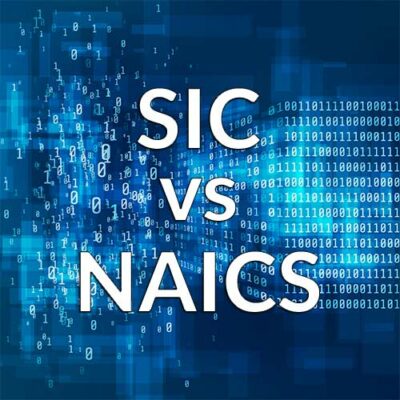SIC codes and NAICS codes are lists of industry classifications. The industry classifications include the Standard Industrial Classification (SIC) and the North American Industry Classification System (NAICS)
What is a SIC Code?
 The SIC Code (Standard Industry Classification) is the original code system used by the U.S. government to classify businesses, aimed to represent major industries, sub-class and specific function/product. SIC codes were developed in the 1930s to help consolidate information and provide statistical information to government agencies. The information was used to help make decisions about necessary infrastructure, investments and regulations to further support industrial growth.
The SIC Code (Standard Industry Classification) is the original code system used by the U.S. government to classify businesses, aimed to represent major industries, sub-class and specific function/product. SIC codes were developed in the 1930s to help consolidate information and provide statistical information to government agencies. The information was used to help make decisions about necessary infrastructure, investments and regulations to further support industrial growth.
SIC Codes, although extremely useful at the start, ran into issues of mismatches, overlapping and ambiguous descriptions. In addition, their limited scope of classification code availability (due to only two digits, followed by one digit for each additional category) put restraints on adding new emerging industries and functions. Updates to the SIC code system continued through to to 1987 when planning began on a replacement coding system.
Planning for the NAFTA agreement as a Free Trade economic community between the U.S.A, Mexico, and Canada led to a new approach for a classification system for the member countries. SIC codes required an update and was in need of more specific classifications. Therefore the member countries developed a new system called NAICS.
What is a NAICS Code?
In 1997 a new coding system NAICS (North American Industry Classification System) was developed. These codes (which were six digits long) include business processes and newer types of businesses, including service industries and technology companies. They offered more scope for adding various new industries and functions, as well as clearing ambiguous codes.
How Do SIC Codes and NAICS Codes Work?
Both the SIC codes and the NAICS codes classify in broad categories and then break down the classifications into more detailed sub-categories. For example, SIC codes 52-59 are for retail trades. Classification 54 is food stores, then 541 is grocery stores, 542 is meat and fish markets, and so on. Then within the 541 category, 541103 is convenience stores, 541106 is kosher markets, etc.
The classifications may change periodically, so keep that in mind and use the most recent version of your code.
How Can I Use These Codes for Marketing?
Search for potential customers. As you can see, you can look up businesses that buy what you have to sell. Using the example above, if you want to sell to convenience stores in a specific area, you can look up businesses in your area with the 541103 SIC code.
Find competitors. In the same way, you can look up possible competitors using your code, and do a location search.
Rent lists. You can rent lists of businesses to send information to potential customers. The advantage of using the SIC or NAICS code is that you have a very targeted list of exactly the right company to promote your product or service to.
If you have further questions, do not hesitate to contact us and we can assist you with this and other campaign questions you may have.






